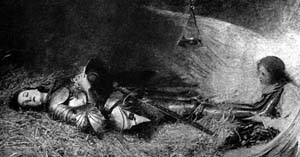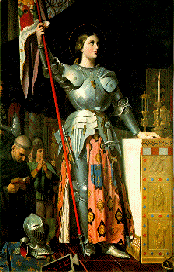The poster “Joan of Arc,” by Haskell Coffin (1878-1941), was commissioned by the United StatesTreasury Department to urge people to buy war savings stamps. Stamps were low-priced and could be pasted in a booklet that when filled was traded for a war bond. The religious image and the intent of the poster is clear; just as God intervened through Joan to save France centuries before, He would, with America’s help, again help His people triumph in France.
The most heroic of France’s saints, Joan of Arc was born to a peasant family from the village of Domremy, located in Lorraine. At thirteen, Joan began hearing the “voices” (of SS. Michael, Catherine, and Margaret) that inspired her. In February 1429, she persuaded Valois captain Robert of Baudricourt to provide an escort for her dangerous journey across the hostile countryside to the court of Charles VII. At Chinon, Joan convinced the king of her divine mission to defeat the English and to assist at his overdue coronation. After a fortnight of formal inquiry into her orthodoxy and chastity by clergymen at Poitiers, Joan won their approval and returned to Chinon. She was given a commanding role in a relief force for Orleans and led reinforcements into the besieged city on April 29. She inspired counterattacks that compelled the English to abandon the siege on May 8. A month later, her army’s decisive victory at Patay ensured Valois control over the Loire valley and destroyed the myth of English invincibility. The subsequent campaign that brought Charles to Reims for a triumphant coronation on July 17 was the high point of Joan’s meteoric career.
Now a political force, Joan became a recognized leader of the court faction favoring renewed war over negotiations with the Anglo-Burgundians. Failure in war soon destroyed her influence. When she was defeated and wounded in an ill-considered assault on Paris in September, Charles arranged a truce and disbanded his army. Though her family had been ennobled, Joan was politically isolated and left the court in the spring to bolster Compiegne’s resistance to a Burgundian siege. She was captured there on May 24, 1430, and to his eternal discredit, abandoned by Charles. Joan’s cross-dressing, claims to divine guidance, and success had aroused suspicions of sorcery, but her subsequent trial and execution for heresy were acts intended primarily to discredit the Valois cause. In response to an accusation by representatives of the University of Paris, her Burgundian captors delivered her for trial at Rouen on Christmas Eve, after seven months of imprisonment at Compiegne, under the direction of Bishop Pierre Cauchon. Eloquent in testimony and steadfast when threatened with torture, Joan submitted to the charges of cross-dressing only when weakened by illness and faced with execution. She was sentenced to a life of imprisonment and penance. After only a few days Joan “relapsed,” resuming men’s clothes once again, and was condemned. Joan, only nineteen years old, was burned at the stake in the public marketplace of Rouen on May 30, 1431. Courageous to the end, she insisted on her innocence and asked the executioner to hold the cross high so she could see it through the flames. Joan remained a controversial figure, and in 1456 Charles VII arranged the annulment of her conviction mainly to clear himself of a suspect association.
Shrouded in myth and exalted by unceasing artistic glorification, Joan endures as a figure inspiring even the most skeptical. Her historical importance could by narrowly construed: she was essentially a military figure whose inspirational leadership and ephemeral battlefield success helped restore the prestige of the Valois dynasty, ensuring its survival but not its eventual triumph. Few however, would restrict themselves to such a reductive assessment. Joan’s courageous example and her martyrdom assure her an enduring role in modern life, not unlike that played by Roland in the Middle Ages. She has become a symbolic figure emblematic of many and varied hopes. Above all, she is the symbol of 20th century France at war with both itself and its German invaders. In the late 19th century, the “maid of Orleans” became a popular heroine who inspired generations of French conservatives in the struggle against the secularism of the Third Republic and reminded all Frenchmen of the need to regain the lost provinces of Alsace and Lorraine seized by Germany in 1870. This popular devotion led to her canonization in the aftermath of the First World War and final confirmation that her greatness transcends if not defies historical analysis.
Short Biography From: Solon, Paul D. “Jeanne D’arc.” Medieval France: An Encyclopedia. Kibler, William and Zinn, Grover, eds. New York: Garland Publishing, 1995.



